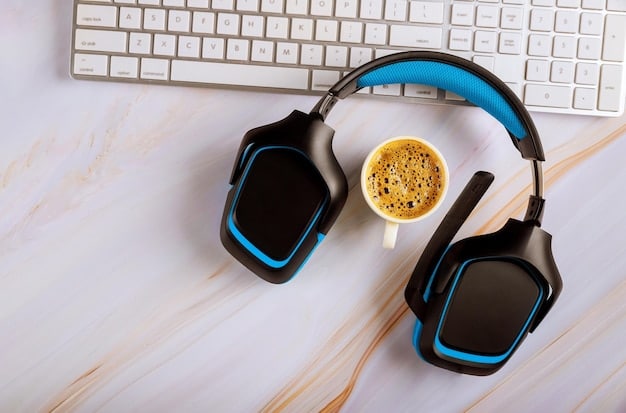Don’t Buy a New Headset: 5 Audio Specs You Need to Know

Don’t Buy a New Headset Before Reading This: 5 Audio Specs That Actually Matter because understanding key audio specifications like frequency response, impedance, sensitivity, driver size, and surround sound capabilities can dramatically improve audio quality and gaming experience.
Are you about to splurge on a brand-new headset, promising crystal-clear audio and immersive gaming experiences? Hold on! Don’t Buy a New Headset Before Reading This: 5 Audio Specs That Actually Matter.
Many manufacturers focus on flashy marketing, but truly understanding the core audio specs will ensure you get the sound quality and performance you expect. So, let’s dive in and uncover the essential details you need to know before making that purchase!
Frequency Response: Hearing the Full Spectrum
Frequency response is one of the most fundamental audio specs. It defines the range of frequencies a headset can reproduce, typically measured in Hertz (Hz). Understanding this range helps you know what kind of sound detail you can expect.
What is the ideal frequency range?
Most humans can hear frequencies ranging from 20 Hz to 20 kHz. A headset with a frequency response that covers this range (or exceeds it slightly) ensures you capture the full spectrum of audible sound. For gaming, this means everything from low-rumbling explosions to high-pitched footsteps.
- 20 Hz – 20 kHz: Standard range for human hearing.
- Wider Range: Some headsets offer a wider range, like 10 Hz – 40 kHz, potentially capturing more nuances, although the audibility is debatable.
- Flat Response: Look for a “flat” or neutral frequency response for balanced sound, which is crucial for accurate audio reproduction.
Frequency response is a key consideration when you Don’t Buy a New Headset Before Reading This: 5 Audio Specs That Actually Matter. Think about the type of audio you’ll be predominantly listening to – gaming, music, or movies – and find a headset that excels in that specific area.

Impedance: Matching Headset to Your Device
Impedance, measured in ohms (Ω), refers to the electrical resistance a headset presents to an audio source. It’s a crucial factor because it affects how easily a headset can be driven by a device.
High vs. Low Impedance
Headsets typically come in low-impedance (16-32Ω) and high-impedance (100Ω or more) variants. Lower impedance headsets are easier to drive and work well with smartphones, laptops, and gaming consoles directly. High-impedance headsets often require a dedicated amplifier to reach their full potential.
When you Don’t Buy a New Headset Before Reading This: 5 Audio Specs That Actually Matter, make sure to check the impedance. Buying a high impedance headset and plugging it directly into your phone will mean you can’t get the full sound quality it can offer.
This is often overlooked, but it makes a world of difference to your listening experience.
- Low Impedance (16-32Ω): Suitable for mobile devices and consoles.
- High Impedance (100Ω+): Requires a headphone amplifier for optimal performance.
- Matching: Ensure your audio source can adequately power the headset’s impedance for the best sound.
In conclusion, impedance is a critical specification to consider when purchasing a new headset. Matching the headset’s impedance to your device ensures you get the best possible audio performance without needing additional equipment.
Sensitivity: How Loud Can It Go?
Sensitivity measures how efficiently a headset converts an electrical signal into sound. It is typically measured in decibels per milliwatt (dB/mW) or decibels per volt (dB/V). A higher sensitivity rating means the headset can produce louder sound levels with less power.
Finding the Right Sensitivity
For most users, a sensitivity rating between 95 dB/mW and 105 dB/mW is adequate. Gamers and audiophiles might prefer slightly higher sensitivity for more immersive audio experiences. However, be cautious about excessively high sensitivity, as it can lead to distortion at high volumes.
Here are a couple of things that makes senstivity something important to be aware of when you Don’t Buy a New Headset Before Reading This: 5 Audio Specs That Actually Matter. An issue is you may end up buying a headset that isn’t suitable for you.
- 95-105 dB/mW: A good range for general use.
- Higher Sensitivity: Can produce louder sound with less power but may distort at high volumes.
- Lower Sensitivity: Requires more power to drive, potentially resulting in quieter sound on low-powered devices.

In essence, sensitivity is a crucial spec to consider when choosing a headset. Opting for a headset with appropriate sensitivity guarantees you get the desired loudness without sacrificing audio quality or needing excessive power.
Driver Size: Bigger Isn’t Always Better
Driver size refers to the diameter of the speaker unit inside the headset, typically measured in millimeters (mm). Larger drivers are often associated with better bass response and overall sound quality, but this isn’t always the case.
The Sweet Spot for Driver Size
Most headsets have drivers ranging from 40mm to 50mm. While larger drivers can move more air, producing deeper bass, the quality of the driver material and tuning also play significant roles. A well-tuned 40mm driver can often outperform a poorly designed 50mm driver.
Making sure you have an appropriate driver size is important when you Don’t Buy a New Headset Before Reading This: 5 Audio Specs That Actually Matter. A quality driver is a major factor in the headset experience.
- 40mm – 50mm: Common driver size range for headsets.
- Material Matters: Driver material (e.g., neodymium, graphene) affects audio quality and frequency response.
- Tuning: Proper tuning is crucial for balanced sound, regardless of driver size.
In summary, driver size is an important factor, but not the only determinant of audio quality. Prioritize headsets with high-quality drivers and expert tuning to ensure a balanced and immersive listening experience.
Surround Sound: Immersive Audio for Gaming and Movies
Surround sound technology creates a sense of spatial audio, making sounds appear to come from different directions. This is particularly useful for gaming and movies, where accurate positional audio can enhance immersion and provide a competitive edge.
Virtual vs. True Surround Sound
There are two main types of surround sound: virtual and true. Virtual surround sound uses software processing to simulate the effect of multiple speakers, while true surround sound uses multiple physical speakers within each ear cup. Virtual surround sound is more common in headsets due to its lower cost and complexity.
With advancements in technology, the immersive of surround sound is an important factor to consider when you Don’t Buy a New Headset Before Reading This: 5 Audio Specs That Actually Matter.
- Virtual Surround Sound: Simulates surround sound using software processing.
- True Surround Sound: Uses multiple physical speakers in each ear cup for a more accurate spatial audio experience.
- Compatibility: Ensure the headset’s surround sound technology is compatible with your platform (e.g., PC, console).
Ultimately, surround sound is a valuable feature for gaming and movie enthusiasts. Selecting a headset with high-quality surround sound technology can significantly enhance your overall audiovisual experience.
| Key Aspect | Brief Description |
|---|---|
| 🎧 Frequency Response | Range of sound a headset can reproduce; aim for 20 Hz – 20 kHz. |
| 💡 Impedance | Electrical resistance; match it to your device (low for mobile, high for amps). |
| 📢 Sensitivity | Efficiency of converting signal to sound; 95-105 dB/mW is ideal. |
| 🔊 Driver Size | Speaker diameter; 40-50mm is common, but quality and tuning matter more. |
Frequently Asked Questions
Frequency response determines the range of sounds the headset can reproduce. A wider range ensures you hear both deep bass and crisp highs, providing a more complete audio experience that helps you decide, should you Don’t Buy a New Headset Before Reading This: 5 Audio Specs That Actually Matter?
Impedance affects how easily your headset can be driven by an audio source. Lower impedance headsets work well with mobile devices, while higher impedance versions may require an amplifier for optimal performance.
Sensitivity determines how loud the headset can get with a given amount of power. Higher sensitivity headsets are louder but may distort at high volumes, affecting your decision to Don’t Buy a New Headset Before Reading This: 5 Audio Specs That Actually Matter.
Not necessarily. While larger drivers can produce deeper bass, the quality of the driver material and tuning are more critical for overall sound quality than just the driver size itself.
Surround sound enhances the spatial audio experience, particularly for gaming and movies. Ensure the headset’s surround sound technology is compatible with your device and consider whether virtual or true surround sound is best for your needs, before potentially resolving to Don’t Buy a New Headset Before Reading This: 5 Audio Specs That Actually Matter.
Conclusion
Understanding these 5 audio specs before you Don’t Buy a New Headset Before Reading This: 5 Audio Specs That Actually Matter can considerably refine your audio experience. Frequency response, impedance, sensitivity, driver size, and surround sound capabilities are all vital parameters.
Taking these specs into account when making your purchase will help ensure you are buying a headset that meets your specific needs and provides the best possible listening experience.





